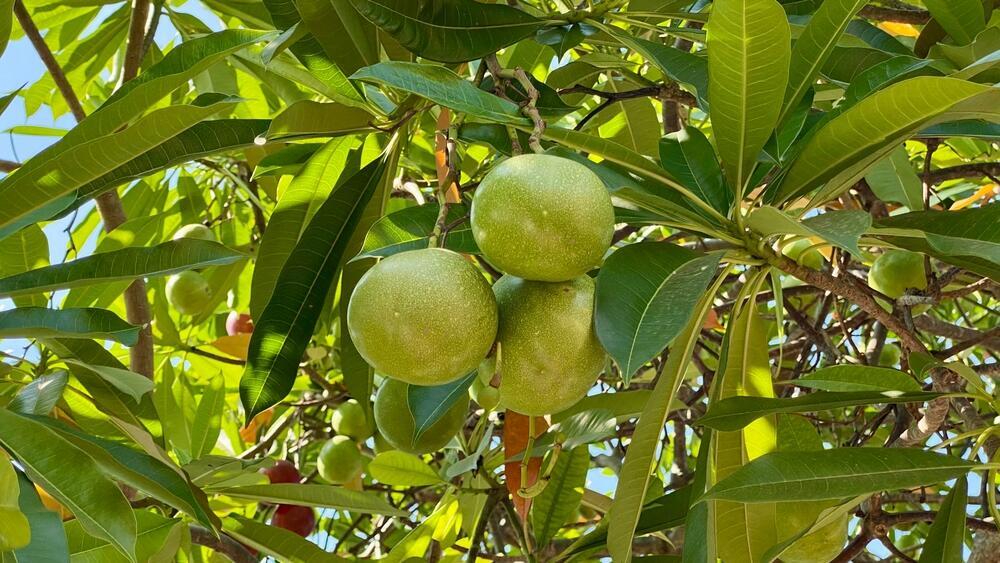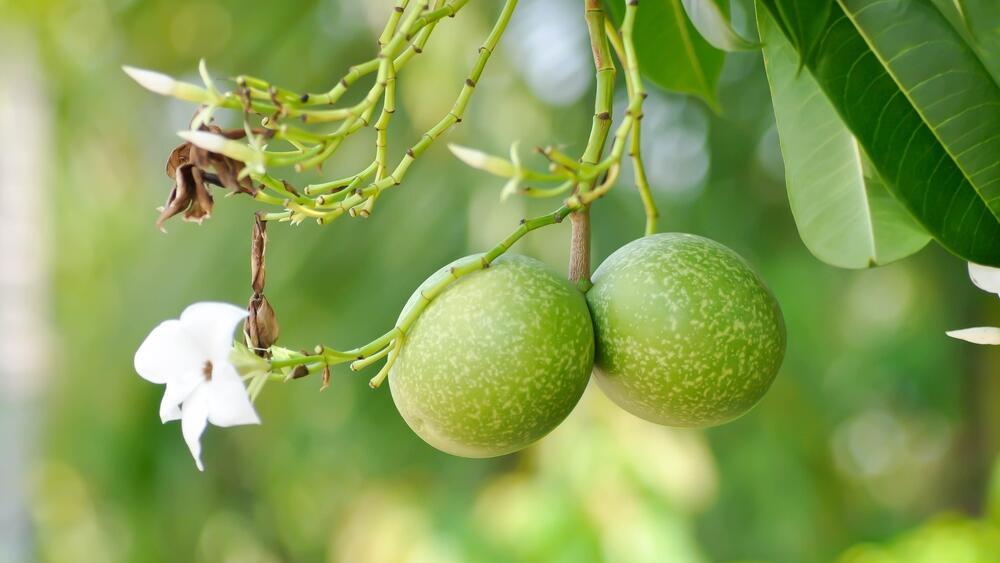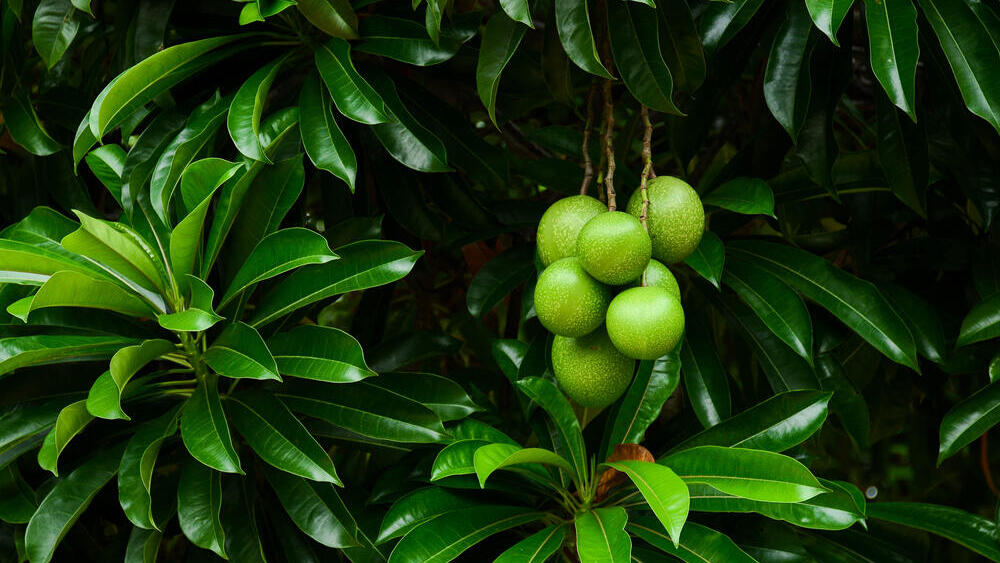Getting your Trinity Audio player ready...
Warning: This article contains spoilers for the White Lotus' third season finale
All seasons of The White Lotus revolve around forbidden fruit, but in season three, the metaphor becomes literal. While the characters dance around the fruit’s precise name, its real-life counterpart is as deadly as the show warns.
The pong-pong tree is real, dangerous and notorious in parts of the world where it grows — so much so that it’s often called the "suicide tree."
The gates of hell
The pong-pong tree, native to India and Southeast Asia, including Thailand, is scientifically known as Cerbera odollam. Fittingly, it’s named after Cerberus, the mythical three-headed dog who guards the underworld in Greek mythology.
A member of the dogbane family (Apocynaceae), which includes several poisonous species like Nerium oleander and Calotropis procera — commonly known in Israel as the “Apple of Sodom” — the pong-pong tree can reach about 12 meters (39 feet) tall.
Its glossy green leaves and fragrant white flowers with a yellow center give it a deceptively serene appearance. Its fruit, resembling a small mango, turns from green to red when ripe. Inside each fruit lies a large, highly toxic seed — mirroring the hidden darkness of many characters in the show.
The seed contains several poisons, chiefly cerberin — a cardiac glycoside that disrupts heart function. These chemicals bind to sodium-potassium pumps in heart muscle cells, causing potassium to accumulate outside the cells while sodium and calcium build up inside.
This results in stronger heart contractions but slower heart rate. The eventual outcome is often fatal — cardiac arrest after hours of nausea, vomiting and arrhythmia. Symptoms of cerberin poisoning also include headaches, fainting, diarrhea, excessive potassium in the blood (hyperkalemia) and low platelet count (thrombocytopenia).
Death by design
Just one seed — or even half — is potent enough to kill an adult. While not every case ends in death, fatal poisonings are common in Asia, particularly in Kerala, a state in southwest India. According to a 2004 study, pong-pong seeds were responsible for half of all plant-related deaths and one in ten fatal poisonings in the region.
Between 1989 and 1999, over 500 deaths were linked to the tree — roughly one per week. Most were suicides, with around 70% of the victims being women.
Researchers suspect the actual numbers are higher. Cerberin is difficult to detect in postmortems, especially in the West where few pathologists or physicians are familiar with it. The internet has also made it easier to obtain the seeds worldwide, leading to poisonings outside Asia — including suicide attempts and deaths in the U.S. and UK.
Get the Ynetnews app on your smartphone: Google Play: https://bit.ly/4eJ37pE | Apple App Store: https://bit.ly/3ZL7iNv
“To our knowledge, no other plant in the world is responsible for as many suicides,” the researchers wrote.
In the season finale, Pam tells Saxon’s father, Timothy Ratliff, that locals call it the “suicide tree” because “people grind up the seeds and eat them when they want to die.”
The pong-pong seed’s extreme bitterness, a common trait among toxic plants, evolved as a natural defense. But humans have found ways to mask it — by grinding the seeds into powder and mixing them into strong or spicy foods or sweet drinks.
In the show, Timothy uses pina coladas to hide the poison. Facing financial ruin, he plans to kill his family — except for his son Lochlan — so they won’t have to suffer without money. But he changes his mind at the last moment and stops them from drinking the cocktails.
Poisoned protein
The next morning, Lochlan performs what may be the show’s most stomach-turning act: he prepares a protein shake in the same blender his father used for the poisoned seeds, without cleaning it first. Before finishing the drink, he falls ill, vomits and loses consciousness. Miraculously, he survives and regains consciousness in his father’s arms.
In real life, cerberin poisoning symptoms typically appear no earlier than three hours after ingestion — so Lochlan’s rapid reaction isn’t very realistic. Unless exposed to an exceptionally high dose, most victims survive for three to six hours before the poison stops the heart.
There is no specific antidote to cerberin but early hospitalization dramatically improves survival. In the early stages, doctors may administer atropine — a compound once derived from the deadly nightshade (Atropa belladonna) — to increase heart rate.
One study found that with atropine, only 24% of hospitalized victims died. Another study showed that using a temporary pacemaker for those unresponsive to atropine reduced the death rate to 12%.
Doctors may also try a digoxin-specific antibody, originally developed for treating overdoses of digoxin, another cardiac glycoside extracted from Digitalis lanata (a foxglove species). At low doses, digoxin has been used for over 200 years to treat heart failure and arrhythmias. Because cerberin closely resembles digoxin structurally, the same antidote may work, but data is still limited.
Lochlan, who received no medical care, shouldn’t have survived. His unlikely recovery may reference the historical use of a related toxic tree, Cerbera manghas — or “sea mango” — in Madagascar.
For centuries, villagers used its seeds in a brutal “trial by ordeal.” Suspects were forced to ingest the poison: survival proved innocence, while death confirmed guilt. This ritual reportedly killed about 3,000 people per year, guilty or not.
- Dr. Noam Levitan holds a Ph.D. in biology from the Weizmann Institute of Science.





